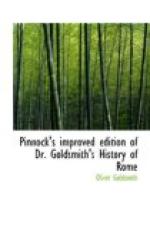3. The mounds of virtue being thus broken down, Nero gave a loose to appetites that were not only sordid, but inhuman. There was a sort of odd contrast in his disposition: for while he practised cruelties sufficient to make the mind shudder with horror, he was fond of those amusing arts which soften and refine the heart. He was particularly addicted, even from childhood, to music, and not totally ignorant of poetry; chariot-driving was his favourite pursuit; and all these he frequently exhibited in public.
4. Happy had it been for mankind, had he confined himself to these; and contented with being contemptible, sought not to become formidable also. His cruelties exceeded all his other extravagancies. 5. A great part of the city of Rome was consumed by fire in his time, and to him most historians ascribe the conflagration. It is said that he stood upon a high tower, during the continuance of the flames, enjoying the sight, and singing, in a theatrical manner to his harp, verses upon the burning of Troy. Of the fourteen quarters into which Rome was divided, only four remained entire. None were permitted to lend assistance towards extinguishing the flames; and several persons were seen setting fire to the houses, alleging that they had orders for so doing. 6. However this be, the emperor used every art to throw the odium of so detestable an action from himself, and fix it upon the Christians, who were at that time gaining ground in Rome.
7. Nothing could be more dreadful than the persecution raised against them upon this false accusation. Some were covered with the skins of wild beasts, and, in that disguise, devoured by the dogs; some were crucified, and others burnt alive. “When the day was not sufficient for their tortures, the flames in which, they perished,” says Ta’citus, “served to illuminate the night:” while Nero, dressed in the habit of a charioteer, regaled himself with a view of their tortures from his gardens, and entertained the people at one time with their sufferings, at another with the games of the circus. 8. In this persecution St. Paul was beheaded, and St. Peter crucified, with his head downwards; a mode of death he chose, as being more dishonourable than that of his divine master. Upon the ruins of the demolished city, Nero founded a palace, which he called his Golden House. It contained within its inclosure, artificial lakes, large wildernesses, spacious parks, gardens, orchards, vineyards, &c. &c. The entrance of the stately edifice was sufficiently lofty to admit a colossal statue of Nero, 120 feet high. The galleries, erected on three rows of tall pillars, were each a mile in length. The palace itself was tiled with gold (probably gilding), the walls covered with the same metal, and richly adorned with precious stones and mother-of-pearl: and the ceiling of one of the banqueting rooms represented the firmament beset with, stars, turning about incessantly night and day, and showering sweet waters on the guests.




